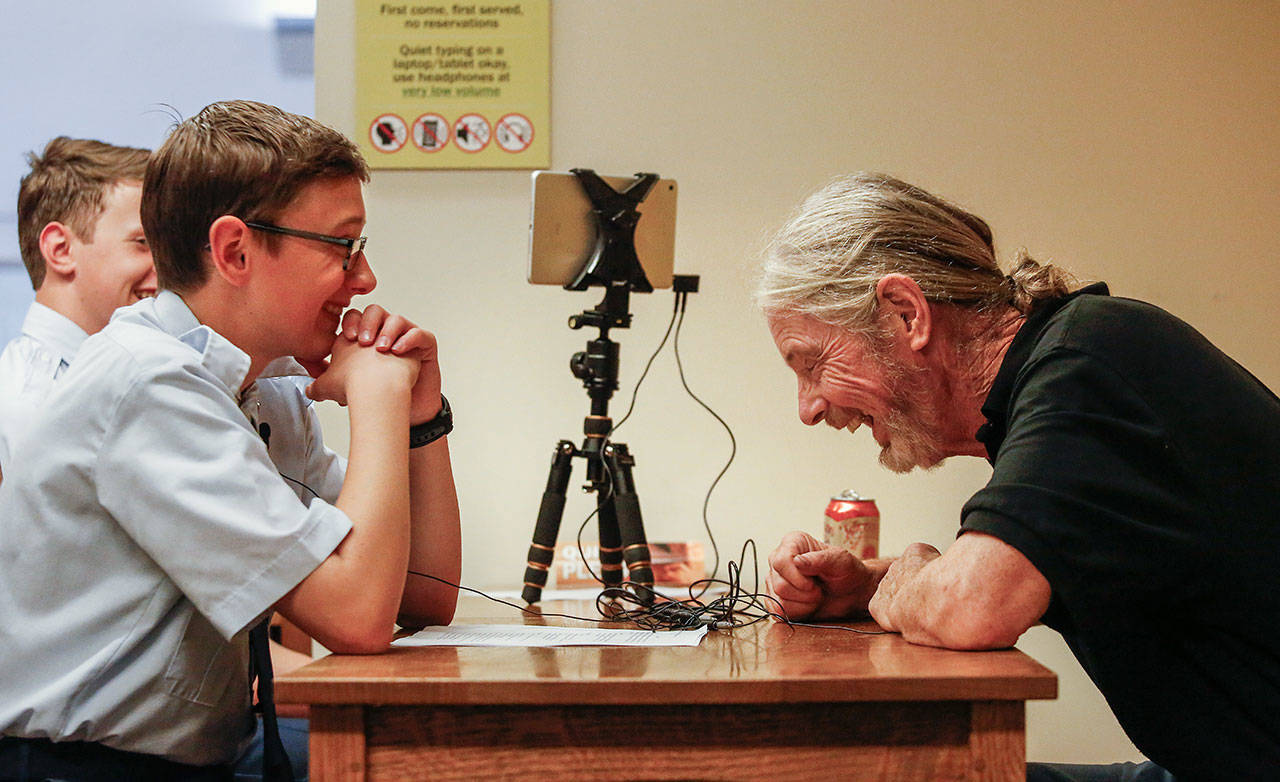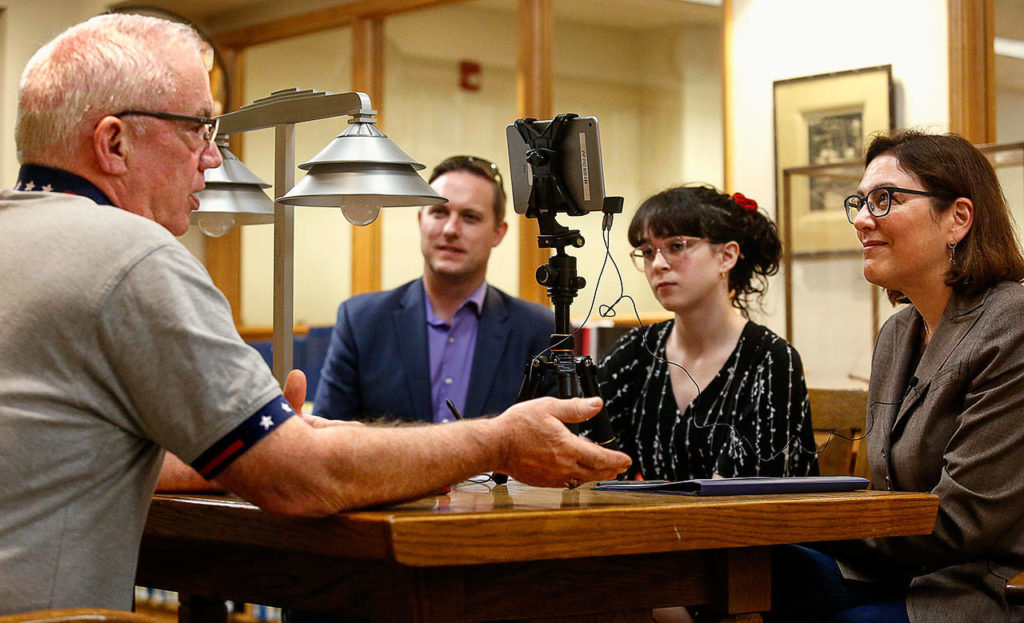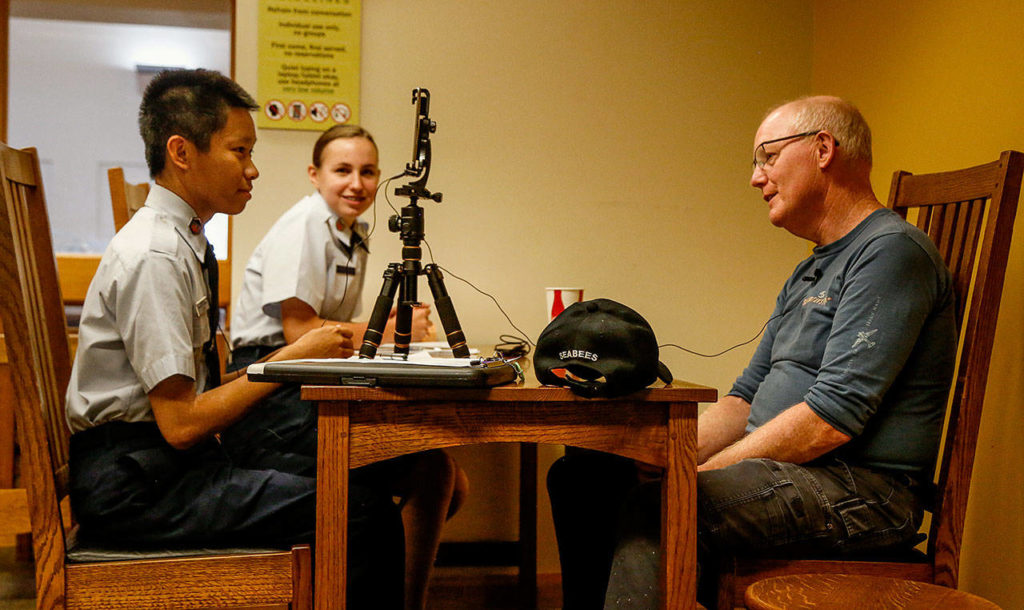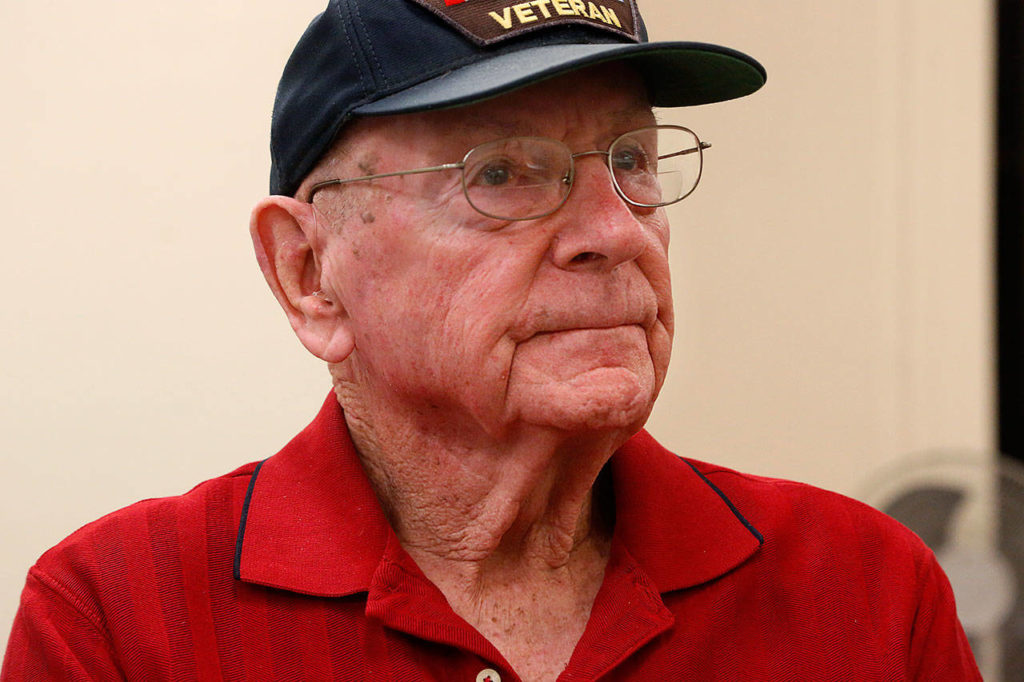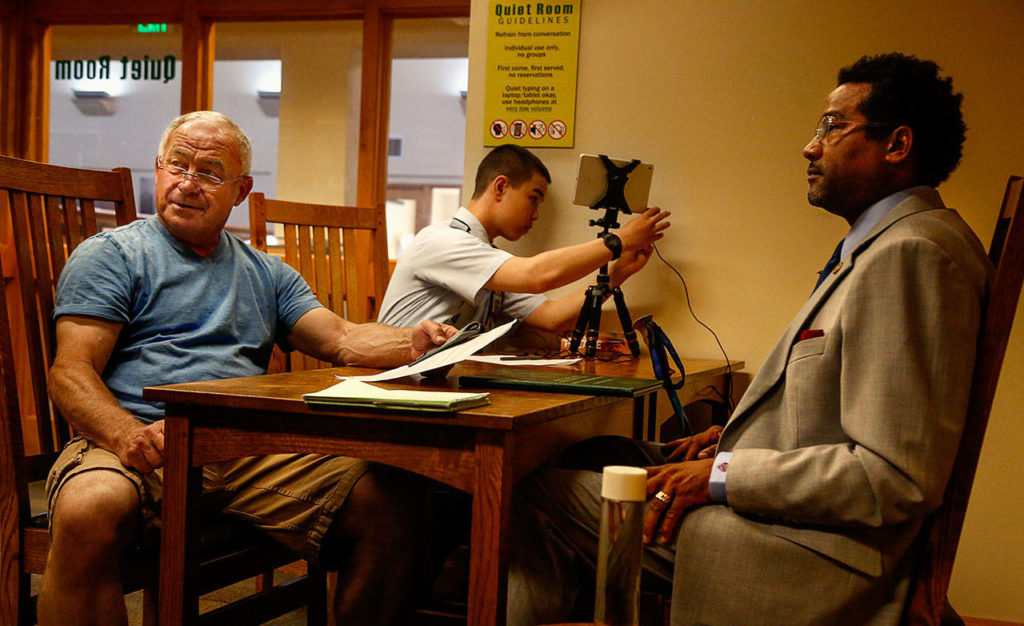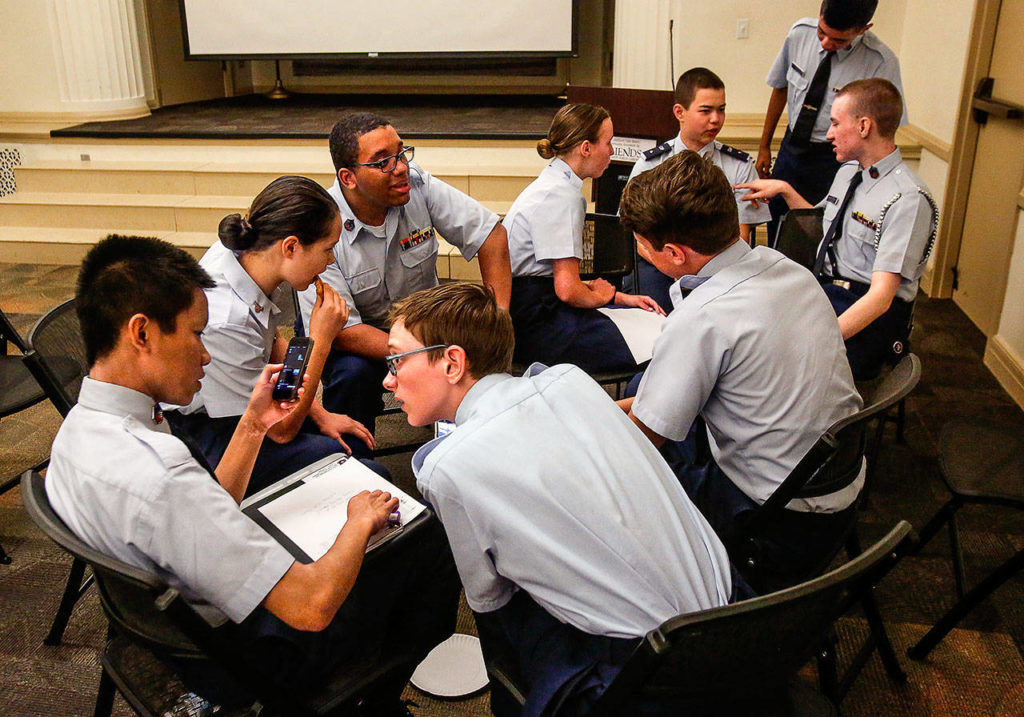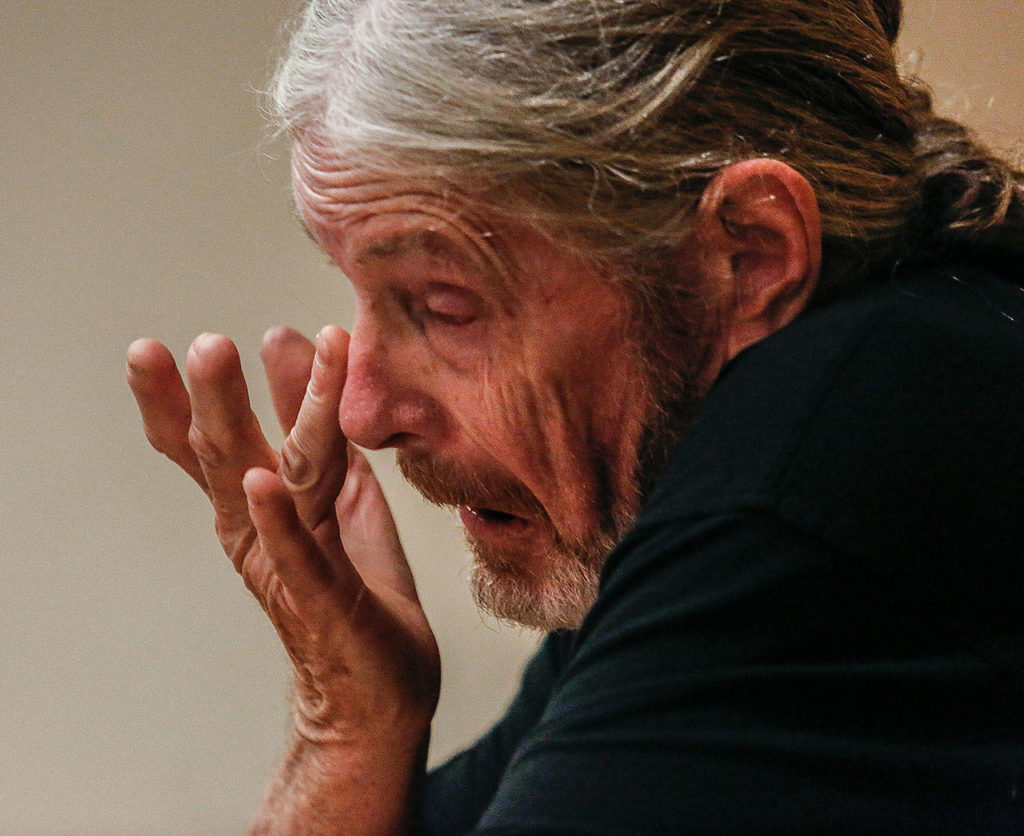Otis Wolfe and Bradley Andrews served in the U.S. military during the same war. Both Vietnam veterans, on Monday they shared vastly different memories.
“I loved my career, my active career,” said Wolfe, 66, commander of VFW Post 921 in Snohomish. He served aboard the USS Sterett near the end of the Vietnam War. “I saw a lot of the world I never would have seen without the Navy,” he said.
Andrews, 69, was certain he’d soon be drafted when he joined the Army in 1968 after graduating from high school on Vashon Island. He trained at Fort Ord, California, with its gun range near the ocean. Soon, orders came for Vietnam. He spent time at Quan Loi, what U.S. forces called LZ Andy.
“Vietnam, it was death and move on,” said the Lynnwood man, whose long hair is now gray. Raised during the Cold War, Andrews said “I didn’t like communism.” He feels he did his job during that unpopular war, but is haunted by it. “I watched a Chinook helicopter fall apart in midair. Five guys died,” he said. In the Army, “they never said, ‘This may come back on you.’”
Wolfe and Andrews were among about 15 people interviewed at the Everett Public Library Monday as part of the Veterans History Project. A program of the Library of Congress, the oral history effort was created by Congress in 2000. Interviewers have heard and recorded stories of veterans and Gold Star families in all 50 states, culling more than 100,000 collections, some with photos and diaries. Many are available online.
Karen Lloyd, director of the Veterans History Project, and Andrew Huber, liaison specialist with the program, were at the library Monday. But many interviewers were teens in uniform — members of the Civil Air Patrol’s Overlake Composite Squadron, based in Redmond.
Wolfe, though, told his story to U.S. Rep. Suzan DelBene, who represents Washington’s 1st Congressional District. “Thanks to those who shared their stories & for sacrifices you’ve made for our country,” the Democratic congresswoman tweeted Monday after interviewing Wolfe.
The Snohomish VFW leader, a hull tech in the Navy, told DelBene he was the second in his family to serve during the Vietnam War. His sister, 74-year-old Darlene Harrington, was an Army nurse. She was in Vietnam during the Tet Offensive. Those attacks by North Vietnamese and Viet Cong fighters in early 1968 took a heavy toll on U.S. forces. “She saw too much,” Wolfe said of his sister.
Describing his shipboard duty, some of it just after a peace agreement was signed in 1973, Wolfe said he experienced “months of routine and moments of terror.” At one point, his ship was dead in the water seven miles off Haiphong harbor. “I didn’t find out until 40 years later that they were shooting at us,” he said.
DelBene asked about Vietnam veterans having “a hard time coming back.”
“I got spit on at Sea-Tac,” Wolfe said, but added “people have a right to think and speak and do what they do.”
Today, with the VFW, Wolfe serves through Operation Ramp It Up, installing ramps at the homes of veterans and their family members with disabilities.
Jay Bonner, 61, walked into the Everett library’s quiet room and put his Seabees cap on the table, then sat down for his talk with 15-year-old Randolph Halim. The Everett man explained to the teen that the Seabees are “the construction part of the Navy — I didn’t go on a ship.”
During training in Mississippi, he learned to operate forklifts, dump trucks and such. “The hardest part was driving a stick shift,” said Bonner, and his teen interviewer quipped “I’ve never driven a stick shift.”
Bonner talked of being deployed in the early 1990s during Operation Desert Shield, which became Desert Storm. At the Navy base on Subic Bay in the Philippines, he missed the birth of his fourth child. On Guam, he loaded bombs onto ships — and remembers writing notes on those bombs to the Iraqi president, saying “Here’s to you, Saddam.”
A high point of Bonner’s service was being posted for two years at Camp David, the presidential retreat in Maryland. He was there in 1978 when President Jimmy Carter witnessed the signing of historic peace accords by Egyptian President Anwar Sadat and Israeli Prime Minister Menachem Begin. He saw them, from a distance.
He attended church with President Carter and First Lady Rosalynn Carter. And once, while out for a run, he found himself jogging between the president and the Secret Service detail.
Bonner, who said the military taught him to be “a better person,” believes all young people should serve for two years, boys especially. “People know I have a military background,” he said. “It’s just who I am.”
At 90, Dan White was one of the oldest interviewees. He enlisted in the Army in 1946, served nearly two years, and was called back in 1950. He and his wife, Carol, brought photos from his duty in the Korean War. One picture shows Heartbreak Ridge, the site of severe fighting north of the 38th Parallel.
A retired middle school teacher, White lives in Redmond but spent years in the Edmonds area. In Korea, he flew a modified Cessna called an L-19. His duties involved adjusting artillery. Back home, he and his wife raised four boys. He earned two degrees, stayed in the reserves and retired as a colonel.
White’s advice to young people? “Learn responsibility, be honest and do a good job.”
Involved with VFW Post 8870 in Edmonds, White said he’d been asked for years to share his story. He’s glad other veterans are telling theirs, and that the Library of Congress will preserve those stories for future generations.
“It’s good — if people are honest with them,” White said.
Julie Muhlstein: 425-339-3460; jmuhlstein@heraldnet.com.
Talk to us
> Give us your news tips.
> Send us a letter to the editor.
> More Herald contact information.
